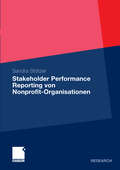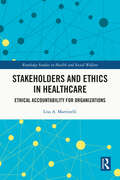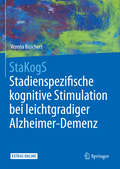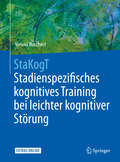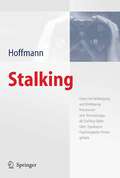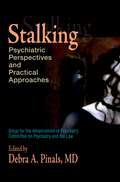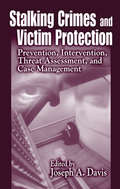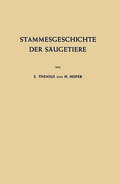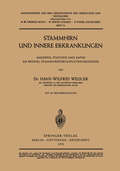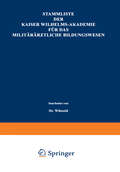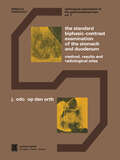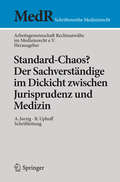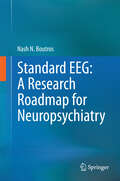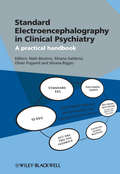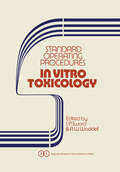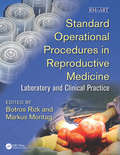- Table View
- List View
Stakeholder Performance Reporting von Nonprofit-Organisationen: Grundlagen und Empfehlungen für die Leistungsberichterstattung als stakeholderorientiertes Steuerungs- und Rechenschaftslegungsinstrument
by Sandra StötzerSandra Stötzer entwickelt ein normatives Modell für eine stakeholderorientierte Leistungsberichterstattung von Nonprofit-Organisationen. Sie gibt konkrete Handlungs- und Gestaltungsempfehlungen für die praktische Ausgestaltung des Performance Reporting und behandelt eine Vielzahl innovativer Einzelaspekte.
Stakeholders and Ethics in Healthcare: Ethical Accountability for Organizations (Routledge Studies in Health and Social Welfare)
by Lisa A. MartinelliThis ground-breaking book uses organizational ethics and stakeholder theory to explore the ethical accountability of leadership in healthcare organizations to their distinct vulnerable stakeholder communities. The book begins with a discussion of the moral agency of healthcare organizations and introduces stakeholder theory. It then looks at key ethical challenges in relation to the confidentiality and privacy of health care data, before turning to child health and interventions around issues such as obesity, maltreatment, and parenting. The book ends by focusing on ethics of care in relation to older people and people with disabilities. An insightful contribution to thinking about ethics for contemporary healthcare management and leadership, this interdisciplinary book is of interest to readers with a background in healthcare, business and management, law, bioethics, and theology.
Stakeholders and Ethics in Healthcare: Ethical Accountability for Organizations (Routledge Studies in Health and Social Welfare)
by Lisa A. MartinelliThis ground-breaking book uses organizational ethics and stakeholder theory to explore the ethical accountability of leadership in healthcare organizations to their distinct vulnerable stakeholder communities. The book begins with a discussion of the moral agency of healthcare organizations and introduces stakeholder theory. It then looks at key ethical challenges in relation to the confidentiality and privacy of health care data, before turning to child health and interventions around issues such as obesity, maltreatment, and parenting. The book ends by focusing on ethics of care in relation to older people and people with disabilities. An insightful contribution to thinking about ethics for contemporary healthcare management and leadership, this interdisciplinary book is of interest to readers with a background in healthcare, business and management, law, bioethics, and theology.
Stakeholders and Scientists: Achieving Implementable Solutions to Energy and Environmental Issues
by Joanna BurgerNation and the World must move forward with development of a range of energy sources and savings, all with attendant environmental problems. Solving these problems, and those remaining from past energy-related activities, will require iteration, inclusion, and collaboration with a wide range of stakeholders, including U.S., State and local governmental agencies, Tribal Nations, scientists, environmentalists, public policy makers, and the general public.
StaKogS - Stadienspezifische kognitive Stimulation bei leichtgradiger Alzheimer-Demenz (Psychotherapie: Manuale)
by Verena BuschertDieses Therapiemanual bietet 14 Einheiten,die sich am stadienspezifischen Funktionsniveau der Teilnehmer mit leichtgradiger AD orientieren.Kognitive Stimulierung stellt einen wissenschaftlich belegten, nicht-medikamentösen Baustein in der Behandlung kognitiver Störungen bei leicht- bis mittelgradiger Alzheimer-Demenz (AD) dar. Experten fordern, diese Therapieoption stärker zu nutzen und in den Gesamtbehandlungsplan von Demenzkranken zu implementieren. Das Programm, das sich an Psychologen, Ergotherapeuten und zertifizierte Gedächtnistrainer richtet, kann als Gruppen- /Einzelangebot sowohl in spezialisierten Gedächtnissprechstunden/Memory-Kliniken als auch in Einrichtungen, die ambulante und stationäre Unterstützungsangebote für Betroffene anbieten, eingesetzt werden.
StaKogT - Stadienspezifisches kognitives Training bei leichter kognitiver Störung (Psychotherapie: Manuale)
by Verena BuschertKognitives Training stellt einen wissenschaftlich belegten, nicht-medikamentösen Baustein in der Behandlung kognitiver Einbußen bei leichter kognitiver Störung (LKS), einem möglichen Vorstadium einer Alzheimer-Demenz (AD), dar. Dieses Trainingsbuch bietet 14 manualisierte Einheiten, die sich am stadienspezifischen Funktionsniveau der Teilnehmer mit LKS orientieren. Das Programm, das sich an Psychologen, Ergotherapeuten und zertifizierte Gedächtnistrainer richtet, kann als Gruppen- /Einzelangebot sowohl in spezialisierten Gedächtnissprechstunden/Memory-Kliniken als auch in Einrichtungen, die ambulante und stationäre Unterstützungsangebote für Betroffene anbieten, eingesetzt werden.
Stalking
by Jens Hoffmann"Stalking" ist mittlerweile ein bekannter Fachbegriff, der synonym mit "obsessiver Verfolgung" und "obsessiver Belästigung" gebraucht wird. – Aber was genau ist "Stalking"? Endlose Briefe, Telefonate und E-Mails, Auflauern und Verfolgen, Drohungen und Liebesbekundungen: Es gibt keine spezifische Verhaltensweise, die bei Stalking immer präsent ist – aber im Kern geht es immer um ein einseitiges Kontaktstreben: Einer will, dass der andere an ihn denkt, der andere möchte ihn aus dem Gedächtnis verbannen.Hoffmann, der als der deutsche Stalking-Experte gilt, zeigt die unterschiedlichen Facetten von Stalking auf. Als theoretischer Hintergrund dienen psychologische Theorien der Bindungsforschung und Lerntheorie. Für Fachleute und Betroffene relevant sind die Analysen, wie gefährlich Stalking in extremen Ausprägungen werden kann und was dagegen getan werden kann.
Stalking: Psychiatric Perspectives and Practical Approaches
by Debra A. PinalsOver the last two decades, stalking has received increasingly widespread attention. The establishment of anti-stalking legislation has helped to spur interest in stalking research and the forensic assessment of stalkers. Popular representations of stalking have made the public more aware of this phenomenon. It has long been the responsibility of mental health professionals to provide assessments of and treatment for stalkers and their victims, and as criminal cases involving defendants charged with stalking become more common, it is now also the responsibility of legal professionals to be knowledgeable about psychiatric aspects of stalking behavior and the risks that so often must be minimized through legal action or a combination of clinical and legal interventions. This volume provides a thorough overview of current scientific and clinical research about stalking, along with practical guidance and original commentary from the Psychiatry and the Law Committee of the Group for the Advancement of Psychiatry, an organization recognized for its contributions to mental health literature. In addition to covering the most widely discussed scientific topics related to stalking, including classification of stalking behaviors, risk assessment and risk management of stalkers, and the stalking experience from the perspective of victims, this book examines celebrity and special target stalking, cyberstalking, forensic assessment, and juvenile and adolescent stalking. Stalking: Psychiatric Perspectives and Practical Approaches provides a novel and comprehensive contribution to a field in need of an up-to-date text, written from the vantage point of forensic psychiatrists who encounter stalkers and their victims in their distinct roles as treatment providers and forensic evaluators. The prism of stalking and the risks involved continue to fascinate and frighten. In pursuit of rounded coverage, the authors have incorporated findings from numerous studies and analyzed these findings from several theoretical perspectives. Every chapter has been written from the vantage point of a committee of nationally recognized forensic psychiatrists who offer their perspectives on this fascinating but complex topic. Mental health professionals, members of the judiciary, law enforcement professionals, media personnel, and the public will no doubt find this text to be an informative and useful resource.
Stalking Crimes and Victim Protection: Prevention, Intervention, Threat Assessment, and Case Management
by Joseph A. DavisAlthough stalking is an age-old phenomenon, it is only recently receiving due attention. In a span of just ten years, all fifty states have passed anti-stalking legislation. For the first time, Stalking Crimes and Victim Protection: Prevention, Intervention, Threat Assessment, and Case Management brings together in one source all the research done
Stammesgeschichte der Säugetiere: Eine Übersicht über Tatsachen und Probleme der Evolution der Säugetiere
by E. Thenius H. HoferStammhirn und Innere Erkrankungen: Kasuistik, Statistik und Kritik am Beispiel Stammhirnstecksplitterverletzter (Monographien aus dem Gesamtgebiete der Neurologie und Psychiatrie #76)
by Hans-Wilfrid WedlerStammliste der Kaiser Wilhelms-Akademie für das militärärztliche Bildungswesen: Im Auftrage der Medizinal-Abteilung des Königl. Kriegsministeriums unter Benutzung amtlicher Quellen
by Paul WätzoldDieser Buchtitel ist Teil des Digitalisierungsprojekts Springer Book Archives mit Publikationen, die seit den Anfängen des Verlags von 1842 erschienen sind. Der Verlag stellt mit diesem Archiv Quellen für die historische wie auch die disziplingeschichtliche Forschung zur Verfügung, die jeweils im historischen Kontext betrachtet werden müssen. Dieser Titel erschien in der Zeit vor 1945 und wird daher in seiner zeittypischen politisch-ideologischen Ausrichtung vom Verlag nicht beworben.
Stammzellen: Neueste Fortschritte
by Khawaja H. HaiderIn diesem Band berichten die Autoren aus führenden Labors, die sich mit Stammzelltheranostik beschäftigen, über die neuesten Fortschritte auf dem Gebiet der Stammzellforschung. Das Buch befasst sich mit vielen Aspekten der stammzellbasierten Therapie und den Fortschritten in der Stammzelltherapie bei Leber-, Augen- und Herz-Kreislauf-Erkrankungen sowie bei Krebs. Dieser Band ist eine Fortsetzung der von Prof. Khawaja Husnain Haider bereits herausgegebenen Bücher zur stammzellbasierten Therapienostik. Es ist ein ideales Buch für Forscher, die sich mit der Entwicklung von Arzneimitteln sowie mit regenerativer Medizin und stammzellbasierter Therapie beschäftigen. Die sekundäre Zielgruppe umfasst Medizinstudenten, Ärzte, Zellpharmakologen, die Arzneimittelindustrie und Forscher, die Stammzellen als Ex-vivo-Krankheitsmodelle für die Arzneimittelentwicklung verwenden.
Stammzellforschung: Ethische und rechtliche Aspekte (Schriftenreihe Ethik und Recht in der Medizin #2)
by Ulrich H. J. Ko¨rtner Christian KopetzkiWo steht die Stammzellforschung, international und in Österreich? In welche Richtung entwickelt sie sich, und welche sind die ethischen, forschungspo- tischen und gesetzgeberischen Herausforderungen? Zu diesen Fragen fand am 17. und 18. Jänner 2008 eine internationale Fachtagung in Wien statt, die vom Institut für Ethik und Recht in der Medizin der Universität Wien und der österreichischen Bioethikkommission beim Bundeskanzleramt veranstaltet wurde. Der vorliegende Band präsentiert die Beiträge des interdisziplinären Symposiums aus Medizin, Biologie, Sozialwissenschaft, Philosophie, Th- logie und Rechtwissenschaft. Die Forschung an humanen embryonalen Stammzellen ist nach wie vor umstritten. Die Gewinnung solcher Stammzellen gilt als ethisch bedenklich, weil dabei in vitro fertilisierte Embryonen zerstört werden müssen. Auch wird der medizinisch-therapeutische Nutzen bzw die Alternativlosigkeit der Forschung an embryonalen Stammzellen in Zweifel gezogen. Umstritten ist allerdings auch, wie seriös die Behauptung ist, alle an embryonale Stammz- len gerichteten Erwartungen ließen sich durch die Beforschung adulter Stammzellen erfüllen. Im November 2007 haben japanische Forscher von einer neuen Methode berichtet, mit der man Hautzellen zu pluripotenten Stammzellen „rep- grammieren“ kann. Auf diese für ethisch unbedenklicher als embryonale Stammzellen gehaltenen induzierten pluripotenten Stammzellen (iPS) richten sich große Hoffnungen. Dennoch werden wohl auch die herkömmlichen Ansätze der Stammzellforschung weiter verfolgt werden, wie zuletzt die Novelle des deutschen Stammzellgesetzes vom April 2008 gezeigt hat. Überdies werfen auch die iPS neue ethische und rechtliche Fragen auf. Die gesetzlichen Regelungen der Stammzellforschung sind internationalwie auch innerhalb der Europäischen Union sehr unterschiedlich. Österreich verfügt bislang über keine umfassende gesetzliche Regelung dieser Materie.
Stance and Motion: Facts and Concepts
by V.S. Gurfinkel M.E. Ioffe J. Massion J.P. RollThis book dealing with stance and motion was planned in June 1986 at a meeting held in Moscow and Leningrad between a group of Soviet and French scientists interested in motor control. This meeting took place in the framework of an exchange program between the USSR Academy of Seiences and the French Centre National de la Recherche Scientifique. It was very successful event and was greatly appreciated by all those who attended it. Several participants put forward the proposal that the possibility of publishing a book was worth exploring. What were the reasons for publishing a book on stance and motion ? The interest aroused in the participants by each others contributions was not a sufficiently decisive argument. It was feit, however, that a large proportion of the orginal material presented at the meeting, especially in the field of posture and locomotion but also on other aspects covered by the book could be presented in a summarized form which should appeal to a larger audience because the facts and hypotheses they contained especially those from the Soviet participants, were not very familiar among international circles, and that many scientists would appreciate having a single volume containing a survey ofthe current state of research in this field. This was also the opinion of Plenum Press, who agreed to publish the book. Each participant at the meeting submitted a paper which was examined by two referees before being accepted.
Stand und Gegenstand chirurgischer Forschung
by F. W. Eigler H. J. Peiper F. W. Schildberg J. Witte V. ZumtobelThe Standard Biphasic-Contrast Examination of the Stomach and Duodenum: Method, Results, and Radiological Atlas (Series in Radiology #1)
by J.O. Op den OrthStandard-Chaos? Der Sachverständige im Dickicht zwischen Jurisprudenz und Medizin (MedR Schriftenreihe Medizinrecht)
by ArbeitsgemeinschaftWie, in welcher Form und vor allem durch wen wird bestimmt und entschieden, dass der aus haftungsrechtlicher Sicht geforderte Facharztstandard bzw. Standard in der medizinischen Behandlung eingehalten worden ist? Kann überhaupt aus rechtswissenschaftlicher Sicht das Recht den Standard festlegen? Wird nicht vielmehr durch den so häufig kritisierten „Richter in Weiß“, d.h. dem gerichtlich bestellten Sachverständigen der Standard definiert und das Tatgericht an dessen Ausführungen und Definitionen gebunden? Die Autoren stellen dar, welche rechtlichen und naturgemäß auch medizinischen Vorgaben berücksichtigt werden müssen, um den Standard zu definieren und zur Grundlage einer tatrichterlichen Entscheidung zu machen. Neben der rechtswissenschaftlichen und medizinischen Frage, wie der Standard bestimmt wird, muss unbedingt diskutiert werden, ob der gerichtlich bestellte Sachverständige oder Gutachter einer besonderen Qualifikation und Ausbildung bedarf. In keinem Fall darf und soll das im Thema genannte „Standard-Chaos“ in der Prozesswirklichkeit akzeptiert werden. Das Buch unternimmt daher eine umfassende Darstellung, wie der Standard in der Medizin zu bilden ist und welche rechtsstaatlichen und prozessrechtlichen Bedingungen hierfür erfüllt sein müssen.
Standard EEG: A Research Roadmap for Neuropsychiatry
by Nash N. BoutrosThis volume is designed to serve as a reference source containing both historical and recent references with a special focus on the existing gaps of knowledge regarding EEG deviations in psychiatric populations. Every chapter begins by outlining the clinical issues, then reviews available literature and concludes by highlighting a) currently supportable findings, and b) open research questions. In some chapters the author makes suggestions regarding the research design that will most likely lead to generating data that can move the field towards resolving unresolved issues.
Standard Electroencephalography in Clinical Psychiatry: A Practical Handbook
by Nash N. Boutros Silvana Galderisi Oliver Pogarell Silvana RiggioThis book provides a concise overview of the possible clinical applications of standard EEG in clinical psychiatry. After a short history, the book describes the physiologic basis of the EEG signal, then reviews the principles of EEG in terms of technical backgrounds and requirements, EEG recording and signal analysis, with plentiful illustrations of the most frequent biological or technical artefacts. Normal EEG patterns and waveforms for easy reference are clearly presented, before the detailed description of abnormal patterns. With the basic information in hand, the reader progresses to an account of the role of EEG in the diagnostic work up in psychiatry, covering nonconvulsive status epilepticus, frontal lobe seizures and non-epileptic seizures. The clinical application of EEG in both childhood and adult disorders follows, including many case vignettes. The effects of psychotropic drugs on EEG are highlighted. The book closes with a discussion of currently available certification venues for Clinical Neurophysiology along with limitations of each venue. It calls for the development of training guidelines and certification processes specific to Psychiatric Electrophysiology. The material is clearly presented throughout, with plenty of figures, tables with summaries of relevant findings, flow diagrams for diagnostic work-up, boxes with learning points, and short lists of key references. We fully expect the book will become the standard teaching source for psychiatry residents and fellows, as well as a useful resource for practising psychiatrists and clinical psychologists. Praise for the book: "This distinguished group of editors has put together chapters that represent an excellent practical handbook on electroencephalography in clinical psychiatry, now a very important topic. I highly recommend it not only to psychiatrists, but also to anyone interested in neuroscience." John R. Hughes, DM (Oxon), MD, PhD, Professor of Neurology, University of Illinois Medical Center, at Chicago, Illinois, USA
Standard Electroencephalography in Clinical Psychiatry: A Practical Handbook
by Nash N. Boutros Silvana Galderisi Oliver Pogarell Silvana RiggioThis book provides a concise overview of the possible clinical applications of standard EEG in clinical psychiatry. After a short history, the book describes the physiologic basis of the EEG signal, then reviews the principles of EEG in terms of technical backgrounds and requirements, EEG recording and signal analysis, with plentiful illustrations of the most frequent biological or technical artefacts. Normal EEG patterns and waveforms for easy reference are clearly presented, before the detailed description of abnormal patterns. With the basic information in hand, the reader progresses to an account of the role of EEG in the diagnostic work up in psychiatry, covering nonconvulsive status epilepticus, frontal lobe seizures and non-epileptic seizures. The clinical application of EEG in both childhood and adult disorders follows, including many case vignettes. The effects of psychotropic drugs on EEG are highlighted. The book closes with a discussion of currently available certification venues for Clinical Neurophysiology along with limitations of each venue. It calls for the development of training guidelines and certification processes specific to Psychiatric Electrophysiology. The material is clearly presented throughout, with plenty of figures, tables with summaries of relevant findings, flow diagrams for diagnostic work-up, boxes with learning points, and short lists of key references. We fully expect the book will become the standard teaching source for psychiatry residents and fellows, as well as a useful resource for practising psychiatrists and clinical psychologists. Praise for the book: "This distinguished group of editors has put together chapters that represent an excellent practical handbook on electroencephalography in clinical psychiatry, now a very important topic. I highly recommend it not only to psychiatrists, but also to anyone interested in neuroscience." John R. Hughes, DM (Oxon), MD, PhD, Professor of Neurology, University of Illinois Medical Center, at Chicago, Illinois, USA
Standard Operating Procedures Analytical Chemistry and Metabolism
by I. P. Sword A. W. WaddellThis is the fourth volume of Standard Operating Procedures (SOPs) compiled from documents prepared in these laboratories in part fulfilment of the requirements of various Good Laboratory Practice (GLP) regulations and guidelines. SOPs have now become an everyday feature of work in most industrial and contract toxicology laboratories. They provide a written definition of the mechanics of unit operations which together comprise the framework for experiments in safety evaluation. Metabolic studies and analytical chemistry are closely linked to toxicology since they embody essential aspects of the overall assessment of product safety. Some authorities consider certain parts of these subjects to be outwith the scope of the GLP requirements but for the reasons stated this is contrary to our own view. We have tried where possible to define in SOP format for use in our own laboratories the unit operations involved in these disciplines and they form the basis of this volume. Some relevant material from previous volumes has been brought together in updated form and is also presented here for completeness. Dr I P Sword Managing Director Inveresk Research International Musselburgh EH21 7UB Scotland ix Introduction GENERAL 1. The Food and Drug Administration of the US Government published its Good Laboratory Practice Regulations for Non-Clinical Laboratory Studies in the Federal Register (22 December 1978). The Regulations are the culmin ation of a number of years of investigation into the standards to which safety evaluation studies were performed in laboratories in the USA.
Standard Operating Procedures In Vitro Toxicology
by I. P. Sword S. D. ThomsonWhen Volume 1 (Toxicolpgy) in this series of Standard Operating Procedures was pub lished in early 1979, the FDA's Good Laboratory Practice Regulations did not have the force of United States Law, but nevertheless had a substantial impact on the conduct of toxicology in laboratories throughout the world. These Regulations are now in force, and Volume 2 (Pathology) was published later the same year. Our critics have implied that we have attempted to reduce toxicology to the level of the cookery book, or alternatively that we seek to impose our standards on others, In some sinister way ensuring that the IRI code will become the international norm. We dismiss these criticisms as arrant nonsense. The many thousands of volumes already sold worldwide can provide at best a framework for adaptation to suit local laboratory condi tions, and thus speed to GLP compliance those organisations which might otherwise have remained foundering at the starting post. If Volumes 1 and 2 of this series have con tributed anything to the conduct of toxicology it must surely be in those non-English speaking nations which, because of the international nature of pharmaceutical and chemical trading, are required by commercial pressures to be in compliance with a foreign law formulated in unfamiliar terminology and introduced for reasons that are not immediately obvious. Much has happened in the short period of time since Volumes 1 and 2 were published.
Standard Operational Procedures in Reproductive Medicine: Laboratory and Clinical Practice (Reproductive Medicine and Assisted Reproductive Techniques Series)
by Botros Rizk Frcog Frcs Hcld Facog Fac Markus MontagCompiled by two experts in Reproductive Medicine, with contributions from internationally respected specialists, this innovative text lets the whole team in Reproductive Medicine get literally on the same page. Taking a cook-book approach to the operational procedures in the laboratory and in the clinic, it details what needs to be prepared in advance, what needs to be prepared earlier the same day, and what steps to take before, during, and after the procedure itself. This is an essential tool for ensuring all staff - whether experienced or starters - can be confident in their tasks and are in touch with what is expected of them and their colleagues.
